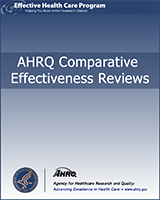NCBI Bookshelf. A service of the National Library of Medicine, National Institutes of Health.
This publication is provided for historical reference only and the information may be out of date.
Excerpt
The purpose of this review is to evaluate the comparative effectiveness of tamoxifen citrate, raloxifene, and tibolone to reduce risk for primary breast cancer, assess the nature and magnitude of harms, and examine how benefits and harms vary by age, breast cancer risk status, and other factors. In addition, it examines issues related to clinical effectiveness, such as patient choice, concordance, adherence, and persistence of use, and evaluates methods to appropriately select patients for medication therapy to reduce risk of breast cancer.
Contents
- Preface
- Acknowledgments
- Executive Summary
- Introduction
- Methods
- Results
- Description of Primary Prevention Trials
- Key Question 1. In adult women without pre-existing breast cancer, what is the comparative effectiveness of selective estrogen receptor modulators (SERMs) tamoxifen citrate and raloxifene, and the selective tissue estrogenic activity regulator (STEAR) tibolone, when used for the primary prevention of breast cancer on improving short-term and long-term outcomes
- Key Question 2. What is the evidence for harms of tamoxifen citrate, raloxifene, and tibolone when used for primary prevention of breast cancer?
- Key Question 3. How do outcomes for tamoxifen citrate, raloxifene, and tibolone when used for primary prevention of breast cancer vary by heterogeneity in subpopulations?
- Key Question 4. What is the evidence that harms or secondary potential benefits listed above affect treatment choice, concordance, adherence, and persistence to treatment with tamoxifen citrate, raloxifene, and tibolone when used for primary prevention of breast cancer?
- Key Question 5. What methods, such as clinical risk assessment models, have been used to identify women who could benefit from breast cancer medications to reduce risk of breast cancer?
- Summary and Discussion
- Future Research
- References
- Abbreviations
- Appendixes
Prepared for: Agency for Healthcare Research and Quality, U.S. Department of Health and Human Services.1 Contract No. 290-2007-10057-1. Prepared by: Oregon Evidence-based Practice Center.
Suggested citation:
Nelson HD, Fu R, Humphrey L, Smith ME, Griffin JC, Nygren P. Comparative Effectiveness of Medications To Reduce Risk of Primary Breast Cancer in Women. Comparative Effectiveness Review No. 17. (Prepared by Oregon Evidence-based Practice Center under Contract No. 290-2007-10057-1.) Rockville, MD: Agency for Healthcare Research and Quality. September 2009. Available at: www.effectivehealthcare.ahrq.gov/reports/final.cfm.
This report is based on research conducted by the Oregon Evidence-based Practice Center (EPC) under contract to the Agency for Healthcare Research and Quality (AHRQ), Rockville, MD (Contract No. 290-2007-10057-1). The findings and conclusions in this document are those of the authors, who are responsible for its contents, and do not necessarily represent the views of AHRQ. Therefore, no statement in this report should be construed as an official position of AHRQ or of the U.S. Department of Health and Human Services.
The information in this report is intended to help clinicians, policymakers, and others make informed decisions about the provision of health care services. This report is intended as a reference and not as a substitute for clinical judgment.
This report may be used, in whole or in part, as the basis for development of clinical practice guidelines and other quality enhancement tools, or as a basis for reimbursement and coverage policies. AHRQ or U.S. Department of Health and Human Services endorsement of such derivative products may not be stated or implied.
- 1
540 Gaither Road, Rockville, MD 20850. www
.ahrq.gov
